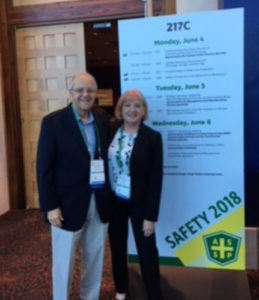The American Society of Safety Professionals 2018 Professional Development Conference, June 4-6, in San Antonio, Texas, was attended by well over 4,500 people who came together to learn, share and network. There were many papers and large session presentations.
 The rapid growth of active shooter incidents was one of the main areas of concern. The FBI and other experts gave talks about this, with their main focus on the active shooter incident itself. Most active shooter situations are conducted by men. Most of these occur in places of business. There is no typical profile for these people who come from all walks of life.
The rapid growth of active shooter incidents was one of the main areas of concern. The FBI and other experts gave talks about this, with their main focus on the active shooter incident itself. Most active shooter situations are conducted by men. Most of these occur in places of business. There is no typical profile for these people who come from all walks of life.
All the presenters emphasized the need for having a strong plan of action so that the organization is ready if this terrible situation occurs. Most organizations have good plans in the event of a fire and practice fire drills. Something similar to this is needed in the event of an active shooter incident.
Claire and I made a presentation on Partner-Centered Leadership: Reducing Workplace Violence and Eliminating Waste. We looked at workplace violence from a whole systems perspective, beginning with the lack of respect which leads to harassment, bullying, workplace injuries, violent behavior, and deaths from murder and suicide. Our workplaces that tolerate the lack of respect and these other behaviors are incubators for violent behaviors and, at the minimum, for hostile workplaces.
We at Nagele, Knowles and Associates, want to engage with organizations to look at the whole range of behaviors and develop together, an effective plan that is suitable for their particular situation. This is a complex, messy problem requiring us to help the people to solve this complex problem. We use a focused dialogic process that brings everyone together to build the best plans possible.
The elimination of workplace violence saves the organization a lot of money by reducing arguments, grievances, absenteeism, and high turnover. It also opens up new potential by opening up the free flow of information among the people. Ideas can be exchanged and developed, new and safer procedures created, and more problems can be solved. People create better, healthier relationships other than looking out for each other’s wellbeing. New potential for the business often emerges from the open conversations. All these things lead to the potential for higher profits.
When an organization uses a whole systems approach to the elimination of workplace violence, the people win because it is a good place to work, and the organization wins because they stop wasting money and open up new possibilities for better earnings.
If you are interested in receiving our blueprint booklet for reducing the risk of workplace violence (from the inside or the outside), please contact us at NageleKnowlesAndAssociates.com. We’ll be happy to send you a copy.
What People are Saying…
On May 18, 2018, we (Nagele, Knowles and Associates) held a workshop in Tampa. It was billed, “What You Need to Know about Reducing the Risk of Workplace Violence.” Feedback was excellent. What we found is that people do have some burning questions, and came away with new learning from this session.
Here are some reflections:
- I did not realize how much the “culture side of the organization” is involved in preventing workplace violence. The continuum of incivilities to bullying to harassment to vengeful acts to even murder is an eye-opener. Especially because supervision must know how to intervene.
- I realize now, how employee engagement fits. I’m anxious to learn more about having in place an integrated, constructive dialog process for our in-tact work groups to use to stop bullying and harassment while having a positive engagement approach.
- More and more I see how important it is for the every-day interactions we have to be keen on lifting up the concerns around employees that may be showing warning clues…so we pay attention…and do what we need to do, quickly.
- I think every workplace needs to have some Active-shooter training (at the minimum).
- Why are so many supervisors “weak in their leadership?” Why do they ignore bad behaviors? (Yes, we do know the answer to that!)







Speak Your Mind